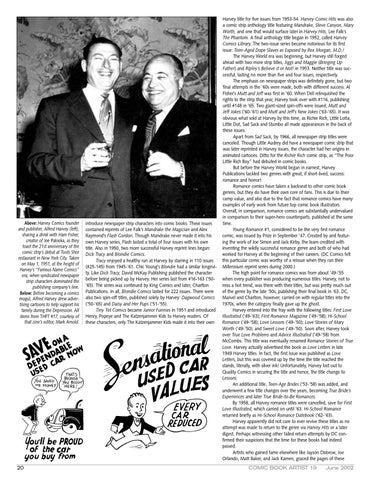Above: Harvey Comics founder and publisher, Alfred Harvey (left), sharing a drink with Ham Fisher, creator of Joe Palooka, as they toast the 21st anniversary of the comic strip’s debut at Toots Shor restaurant in New York City. Taken on May 1, 1951, at the height of Harvey’s “Famous Name Comics” era, when syndicated newspaper strip characters dominated the publishing company’s line. Below: Before becoming a comics mogul, Alfred Harvey drew advertising cartoons to help support his family during the Depression. All items from THFT #17, courtesy of that zine’s editor, Mark Arnold.
20
introduce newspaper strip characters into comic books. These issues contained reprints of Lee Falk’s Mandrake the Magician and Alex Raymond’s Flash Gordon. Though Mandrake never made it into his own Harvey series, Flash lasted a total of four issues with his own title. Also in 1950, two more successful Harvey reprint lines began: Dick Tracy and Blondie Comics. Tracy enjoyed a healthy run at Harvey by starring in 110 issues (#25-145) from 1945-’61. Chic Young’s Blondie had a similar longevity. Like Dick Tracy, David McKay Publishing published the character before being picked up by Harvey. Her series last from #16-163 (’50’65). The series was continued by King Comics and later, Charlton Publications. In all, Blondie Comics lasted for 222 issues. There were also two spin-off titles, published solely by Harvey: Dagwood Comics (’50-’65) and Daisy and Her Pups (’51-’55). Tiny Tot Comics became Junior Funnies in 1951 and introduced Henry, Popeye and The Katzenjammer Kids to Harvey readers. Of these characters, only The Katzenjammer Kids made it into their own
Harvey title for five issues from 1953-54. Harvey Comic Hits was also a comic strip anthology title featuring Mandrake, Steve Canyon, Mary Worth, and one that would surface later in Harvey Hits, Lee Falk’s The Phantom. A final anthology title began in 1952, called Harvey Comics Library. The two-issue series became notorious for its first issue: Teen-Aged Dope Slaves as Exposed by Rex Morgan, M.D.! The Harvey World era was beginning, but Harvey still forged ahead with two more strip titles, Jiggs and Maggie (Bringing Up Father) and Ripley’s Believe it or Not! in 1953. Neither title was successful, lasting no more than five and four issues, respectively. The emphasis on newspaper strips was definitely gone, but two final attempts in the ’60s were made, both with different success. Al Fisher’s Mutt and Jeff was first in ’60. When Dell relinquished the rights to the strip that year, Harvey took over with #116, publishing until #148 in ’65. Two giant-sized spin-offs were issued, Mutt and Jeff Jokes (’60-’61) and Mutt and Jeff’s New Jokes (’63-’65). It was obvious what sold at Harvey by this time, as Richie Rich, Little Lotta, Little Dot, Sad Sack and Stumbo all made appearances in the back of these issues. Apart from Sad Sack, by 1966, all newspaper strip titles were canceled. Though Little Audrey did have a newspaper comic strip that was later reprinted in Harvey issues, the character had her origins in animated cartoons. Ditto for the Richie Rich comic strip, as “The Poor Little Rich Boy” had debuted in comic books. But before the Harvey World began in earnest, Harvey Publications tackled two genres with great, if short-lived, success: romance and horror! Romance comics have taken a backseat to other comic book genres, but they do have their own core of fans. This is due to their camp value, and also due to the fact that romance comics have many examples of early work from future top comic book illustrators. Overall, in comparison, romance comics are substantially undervalued in comparison to their super-hero counterparts, published at the same time. Young Romance #1, considered to be the very first romance comic, was issued by Prize in September ’47. Created by and featuring the work of Joe Simon and Jack Kirby, the team credited with inventing the wildly successful romance genre and both of who had worked for Harvey at the beginning of their careers. (DC Comics felt this particular comic was worthy of a reissue when they ran their Millennium reprint series during 2000.) The high point for romance comics was from about ’49-’55 when every publisher was producing numerous titles. Harvey, not to miss a hot trend, was there with their titles, but was pretty much out of the genre by the late ’50s, publishing their final book in ’63. DC, Marvel and Charlton, however, carried on with regular titles into the 1970s, when the category finally gave up the ghost. Harvey entered into the fray with the following titles: First Love Illustrated (’49-’63); First Romance Magazine (’49-’58); Hi-School Romance (’49-’58); Love Lessons (’49-’50); Love Stories of Mary Worth (’49-’50); and Sweet Love (’49-’50). Soon after, Harvey took over True Love Problems and Advice Illustrated (’49-’58) from McCombs. This title was eventually renamed Romance Stories of True Love. Harvey actually advertised this book as Love Letters in late 1949 Harvey titles. In fact, the first issue was published as Love Letters, but this was covered up by the time the title reached the stands, literally, with silver ink! Unfortunately, Harvey lost out to Quality Comics in securing the title and hence, the title change to Lessons. An additional title, Teen-Age Brides (’53-’58) was added, and underwent a few title changes over the years, becoming True Bride’s Experiences and later True Bride-to-Be Romances. By 1958, all Harvey romance titles were cancelled, save for First Love Illustrated, which carried on until ’63. Hi-School Romance returned briefly as Hi-School Romance Datebook (’62-’63). Harvey apparently did not care to ever revive these titles as no attempt was made to return to the genre via Harvey Hits or a later digest. Perhaps witnessing other failed return attempts by DC confirmed their suspicions that the time for these books had indeed passed. Artists who gained fame elsewhere like Jayson Disbrow, Joe Orlando, Matt Baker, and Jack Kamen, graced the pages of these COMIC BOOK ARTIST 19
June 2002
